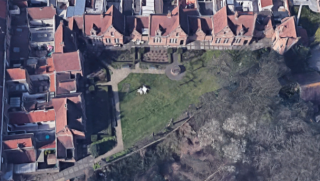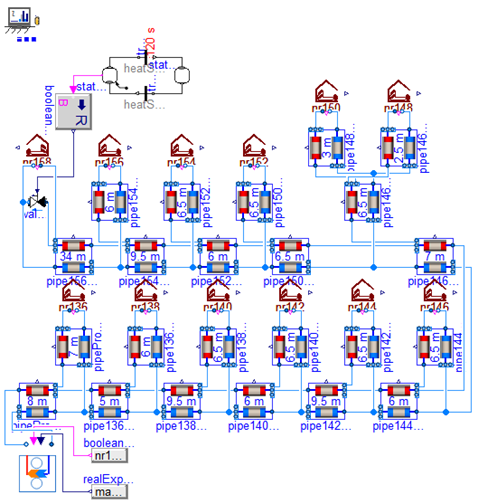Assessing and improving the control of a small-scale fully renewables-based low-temperature thermal network in the historic city center of Bruges

Almshouses De Schipjes is a social housing neighborhood located in the historic city center of Bruges, Belgium. Between 2017 and 2020, the buildings were retrofitted to decrease the heat demand and a fully renewables-based low-temperature thermal network (supply temperature ≤ 50°C) was designed to meet the heat demand of the twelve households. The heat in the network is supplied by a centralized ground source heat pump (GSHP) connected to a borefield (8 boreholes) and thermal solar collectors (limited area to preserve the heritage character), each connected to its own central water storage tank to introduce some extra flexibility in the thermal network. The return water of the thermal network is preheated by the solar collectors in the first tank and then flows to the second tank which is heated by the GSHP to reach the supply temperature of the thermal network. The space heating in every house is provided by a combination of radiators in every room and a floor heating system on the ground floor. Domestic hot water (DHW) is produced by a booster heat pump which upgrades the low-temperature heat in the houses’ thermal network (30-40°C) to the required DHW temperature of 60°C. A simplified hydraulic scheme of the district heating network connected to one building is shown in Figure 1. The Modelica models are shown in Figure 2.
The objective of this case study is to improve the overall performance of the thermal system by assessing enhanced control strategies using dynamic simulations and applying these to the real-life thermal system. The main control rules of the reference rule-based controller (RBC) are:
Current research consists of applying a model predictive controller (MPC), developed using TACO [3], to the simulation model and comparing the results with the previously obtained simulation results of the RBCs.

Fig.1 - Simplified scheme of the final energy system for one house.

Fig.2 - Modelica model of De Schipjes showing the distribution network
The objective of this case study is to improve the overall performance of the thermal system by assessing enhanced control strategies using dynamic simulations and applying these to the real-life thermal system. The main control rules of the reference rule-based controller (RBC) are:
- On/off GSHP control using a hysteresis curve around 50°C;
- Heating curve to determine the supply temperature in the building’s heating system;
- DHW production has priority over SH.
- Preheating of DHW;
- Simultaneous space heating and DHW production;
- FH active during night;
- Heating curve for the DH network.
Current research consists of applying a model predictive controller (MPC), developed using TACO [3], to the simulation model and comparing the results with the previously obtained simulation results of the RBCs.


Factsheet
| Number of buildings | 12 |
| Number of thermal zones (per building) | 1 |
| Complexity of thermal zone model | High-order (white-box) |
| Coupling/Decoupling between district network and buildings | Coupling |
| Simulation tool | Dymola |
| Modelica libraries | Buildings/IDEAS |
| Additional packages/workflows/scripts | StROBe |
| Simulation time | One year |
| Computational time | 1.5 hours |
| Solver and tolerance | Euler 15s |
| CPU speed | 2.6 GHz |
References:
[1] S. Feyaerts, “Impact van de regeling op de performantie van een klein thermisch net voor godshuizen, De Schipjes, te Brugge,” Master Thesis, KU Leuven, Belgium, 2019 (in Dutch).
[2] W. Boydens, S. Feyaerts, A. Vandermeulen, J. Jansen, and L. Helsen. “Control strategy assessment of a small GSHP sourced DH system with end user DHW booster heat pumps,” presented at 13th IEA Heat Pump Conference (online), Jeju, Korea, April 26-29, 2021.
[3] F. Jorissen, W. Boydens, and L. Helsen, “TACO, an automated toolchain for model predictive control of building systems: implementation and verification,” Journal of Building Performance Simulation, vol. 12, no. 2, pp. 180–192, 2019.
[1] S. Feyaerts, “Impact van de regeling op de performantie van een klein thermisch net voor godshuizen, De Schipjes, te Brugge,” Master Thesis, KU Leuven, Belgium, 2019 (in Dutch).
[2] W. Boydens, S. Feyaerts, A. Vandermeulen, J. Jansen, and L. Helsen. “Control strategy assessment of a small GSHP sourced DH system with end user DHW booster heat pumps,” presented at 13th IEA Heat Pump Conference (online), Jeju, Korea, April 26-29, 2021.
[3] F. Jorissen, W. Boydens, and L. Helsen, “TACO, an automated toolchain for model predictive control of building systems: implementation and verification,” Journal of Building Performance Simulation, vol. 12, no. 2, pp. 180–192, 2019.
